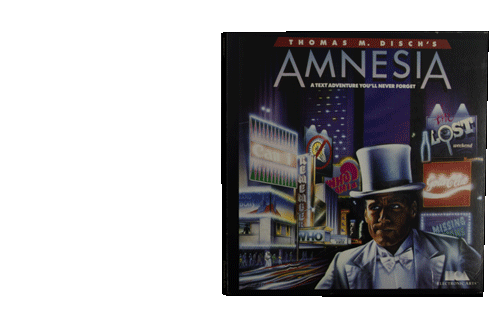GAME HISTORY
When Thomas M. Disch’s Amnesia was in production at Harper & Row, the company brought in Cognetics to handle the game’s programming. Cognetics’ James Terry had already developed a game authoring system called King Edward written in the programming language FORTH in a version, according to Terry, called Atila, for the Apple II. Terry later ported the system to the Commodore 64 and the IBM PC. He reports that Kevin Bentley, whom Terry referred to as “a local kid,” was brought in to do actual programming of Disch’s manuscript into his King Edward game authoring system and, so, is the person credited for the work.
The Game as Bookware
Amnesia was envisioned as "bookware"—that is, a new kind of environment created specifically for the personal computer. Its two 5.25-inch floppy disks were packaged in a booklike folio that, when opened, resembled a newspaper with the author's bio and game information presented as news about NYC. The game was also bundled with a 18-page manual, a command summary, map of Manhattan, x-street indexer, registration mailer, and newsletter subscription postcard.

The Novel as Game
When writing AMNESIA, Disch, an accomplished novelist, experimented with storytelling for the, then, new electronic environment. His 400-page manuscript laid out a narrative game that offers players 10 different endings. One sees players living out their days on a sheep station in Australia with a wife and a house full of children. In another, players are found guilty of a crime they do not remember committing and are given the choice of committing suicide or facing a firing squad. In some cases, they are allowed to meet St. Peter and provide the correct information about their identity to enter heaven. Depending on players’ ability to solve the puzzle, they may never leave The Sunderland Hotel. But if they are persistent, they get to explore the streets and places of NYC in search of who they really are.
A Locative Experience
Disch spent his adult years in New York City, and the game reflects his fascination with the city and its streets. So, while players start the game wandering around in The Sunderland Hotel, they are compelled by the gameplay to search for their identity among the 4000 locations, 650 streets, and entire NYC subway system. Amnesia’s X-Street Indexer, bundled with the game’s floppy disk, shows 30 city blocks and 15 avenues for a total of 450 location combinations player can consult during their exploration.
Cultural Context
The concept of an established print author producing a video game was not new. Besides Pinsky's Mindwheel and Douglas Adams and Steve Meretzky's The Hitchhiker’s Guide to the Galaxy, Sarah Smith, another well-established writer, began work in 1987 on King of Space. This work of interactive fiction was published in 1991 by Mark Bernstein's Eastgate Systems, Inc. and includes numerous games and puzzles players had to solve in order to experience the story. At the same time Smith was starting her work, science fiction writer John McDaid was introduced to hypertext author Michael Joyce and Bernstein, and in 1992 released his hypermedia novel, Uncle Buddy’s Phantom Funhouse also published by Bernstein. Like Smith’s King of Space, Funhouse involves numerous games and puzzles. Ironically, while EA never published another adventure game after Amnesia, Bernstein's company has released a total of 48 titles from 1990 onward.
Physical Media
Amnesia was originally released in 5.25-inch floppy disk for the Apple IIe and later made available for the Commodore 64 and IBM PC. It was packaged in a colorful cardboard folio and included a detailed user’s manual with directions for how to play the game and information about The Sunderland Hotel and its many amenities.
Learn moreThe X-Street Indexer
The floppy disk is also bundled with two finding tools players need to move around Manhattan in search of clues leading to the discovery of their identity. First is the X-Street Indexer. A small inner circle of this tool contains instructions and street names, while the larger outer circle contains numbers. The instructions read: “Align the avenue name on the inner wheel with the street address on the outer wheel. . . . The small window in the inner wheel shows the nearest cross street.”
Map of Manhattan
Also contained in the folio is a trifold map of Manhattan circa the mid-1980s. The far-right section contains the title, “Street and Subway Map to Manhattan”, and an image of a person driving a classic car, the publisher’s name, and text that reads, “Compliments of The SUNDERLAND HOTEL”. The left two pages show a detailed subway map of Manhattan.
